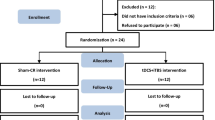Abstract
Electroencephalogram-based brain–computer interface (BCI) has been developed as a new neurorehabilitative tool for patients with severe hemiparesis. However, its application has been limited because of difficulty detecting stable brain signals from the affected hemisphere. It has been reported that transcranial direct current stimulation (tDCS) can modulate event-related desynchronization (ERD) in healthy persons. The objective of this study was to test the hypothesis that anodal tDCS could modulate ERD in patients with severe hemiparetic stroke. The participants were six patients with chronic hemiparetic stroke (mean age, 56.8 ± 9.5 years; mean time from the onset, 70.0 ± 19.6 months; Fugl-Meyer Assessment upper extremity motor score, 30.8 ± 16.5). We applied anodal tDCS (10 min, 1 mA) and sham stimulation over the affected primary motor cortex in a random order. ERD of the mu rhythm (mu ERD) with motor imagery of extension of the affected finger was assessed before and after anodal tDCS and sham stimulation. Mu ERD of the affected hemisphere increased significantly after anodal tDCS, whereas it did not change after sham stimulation. Our results show that anodal tDCS can increase mu ERD in patients with hemiparetic stroke, indicating that anodal tDCS could be used as a conditioning tool for BCI in stroke patients.


Similar content being viewed by others
References
Arroyo S, Lesser RP, Gordon B, Uematsu S, Jackson D, Webber R (1993) Functional significance of the mu rhythm of human motor cortex: an electrophysiologic study with subdural electrodes. Electroencephalogr Clin Neurophysiol 87:76–87
Bindman LJ, Lippold OC, Redfearn JW (1964) The action of brief polarizing currents on the cerebral cortex of the rat (1) during current flow and (2) in the production of long-lasting after-effects. J Physiol 172:369–382
Bohannon RW, Smith MB (1987) Interrater reliability of a modified Ashworth scale of muscle spasticity. Phys Ther 67:206–207
Buch E, Weber C, Cohen LG, Braun C, Dimyan MA, Ard T, Mellinger J, Caria A, Soekadar S, Fourkas A, Birbaumer N (2008) Think to move: a neuromagnetic brain-computer interface (BCI) system for chronic stroke. Stroke 39:910–917
Daly JJ, Cheng R, Rogers J, Litinas K, Hrovat K, Dohring M (2009) Feasibility of a new application of noninvasive brain computer interface (BCI): a case study of training for recovery of volitional motor control after stroke. J Neurol Phys Ther 33:203–211
Fugl-Meyer AR, Jääskö L, Leyman I, Olsson S, Steglind S (1975) The post-stroke hemiplegic patient, I: a method for evaluation of physical performance. Scand J Rehabil Med 7:13–31
Furubayashi T, Terao Y, Arai N, Okabe S, Mochizuki H, Hanajima R, Hamada M, Yugeta A, Inomata-Terada S, Ugawa Y (2008) Short and long duration transcranial direct current stimulation (tDCS) over the human hand motor area. Exp Brain Res 185:279–286
Hendricks HT, van Limbeek J, Geurts AC, Zwarts MJ (2002) Motor recovery after stroke: a systematic review of the literature. Arch Phys Med Rehabil 83:1629–1637
Kang EK, Baek MJ, Kim S, Paik NJ (2009) Non-invasive cortical stimulation improves post-stroke attention decline. Restor Neurol Neurosci 27:645–650
Leocani L, Comi G (2006) Movement-related event-related desynchronization in neuropsychiatric disorders. Prog Brain Res 159:351–366
Matsumoto J, Fujiwara T, Takahashi O, Liu M, Kimura A, Ushiba J (2010) Modulation of mu rhythm desynchronization during motor imagery by transcranial direct current stimulation. J Neuroeng Rehabil 7:27. doi:10.1186/1743-0003-7-27
Nitche MA, Pauslus W (2001) Sustained excitability elevations induced by transcranial DC motor cortex stimulation in humans. Neurology 57:1899–1901
Nitsche MA, Paulus W (2000) Excitability changes induced in the human motor cortex by weak transcranial direct current stimulation. J Physiol 527:633–639
Nitsche MA, Fricke K, Henschke U, Schlitterlau A, Liebetanz D, Lang N, Henning S, Tergau F, Paulus W (2003) Pharmacological modulation of cortical excitability shifts induced by transcranial direct current stimulation in humans. J Physiol 553:293–301
Pfurtscheller G, Aranibar A (1977) Event-related cortical desynchronization detected by power measurements of scalp EEG. Electroencephalogr Clin Neurophysiol 42:817–826
Pfurtscheller G, Lopes da Silva FH (1999) Event-related EEG/MEG synchronization and desynchronization: basic principles. Clin Neurophysiol 110:1842–1857
Platz T, Kim IH, Pintschovius H, Winter T, Kieselbach A, Villringer K, Kurth R, Mauritz KH (2000) Multimodal EEG analysis in man suggests impairment-specific changes in movement-related electric brain activity after stroke. Brain 123:2475–2490
Purpura DP, Mcmurtry JG (1965) Intracellular activities and evoked potential changes during polarization of motor cortex. J Neurophysiol 28:166–185
Shindo K, Kawashima K, Ushiba J, Ota N, Ito M, Ota T, Kimura A, Liu M (2011) Effects of neurofeedback training with an electroencephalogram-based brain–computer interface for hand paralysis in patients with chronic stroke: a preliminary case series study. J Rehabil Med 43:951–957
Welch PD (1967) The use of fast fourier transform for the estimation of power spectra: a method based on time averaging over short, modified periodograms. IEEE Trans Audio Electraacoust 15:70–73
Acknowledgments
This study was partially supported by the Strategic Research Program for Brain Sciences (SRPBS) and Grant-in-Aid for Scientific Research (C) (23500619) of the Ministry of Education, Culture, Sports, Science, and Technology of Japan.
Author information
Authors and Affiliations
Corresponding author
Additional information
Yuko Kasashima and Yayoi Matsushika contributed equally to the study.
Rights and permissions
About this article
Cite this article
Kasashima, Y., Fujiwara, T., Matsushika, Y. et al. Modulation of event-related desynchronization during motor imagery with transcranial direct current stimulation (tDCS) in patients with chronic hemiparetic stroke. Exp Brain Res 221, 263–268 (2012). https://doi.org/10.1007/s00221-012-3166-9
Received:
Accepted:
Published:
Issue Date:
DOI: https://doi.org/10.1007/s00221-012-3166-9




